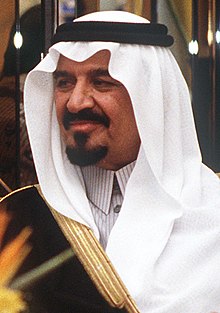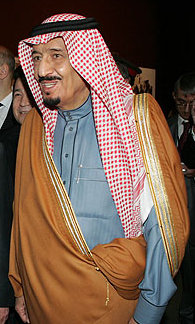

|
|
No edit summary
|
||
| Line 1: | Line 1: | ||
[[File:Fahd bin Abdul Aziz.jpg|thumb|right|King Fahd, eldest of the Sudairi Seven]] |
[[File:Fahd bin Abdul Aziz.jpg|thumb|right|King Fahd, eldest of the Sudairi Seven]] |
||
The '''Sudairi Seven''', also spelled '''Sudairy''' or '''Sudayri''', is the commonly used name for a powerful alliance of seven full brothers |
The '''Sudairi Seven''', also spelled '''Sudairy''' or '''Sudayri''', is the commonly used name for a powerful alliance of seven full brothers within the [[Al Saud|royal family]] of [[Saudi Arabia]]. They are also known as the '''Al Fahd''' (in reference to the eldest brother, the late [[Fahd of Saudi Arabia|King Fahd]]). They are sometimes referred to as the ''Sudairi Clan'' ({{lang-ar|عائلة السديري}}) or the ''Sudairi faction''. After King Fahd's death, the group has been sometimes called the ''Sudairi Six''. |
||
The Sudairi Seven's rise to power can be traced back to the preference shown to them by [[Faisal of Saudi Arabia|King Faisal]]. As a result, the brothers were appointed to a number of key posts within the Kingdom. Fahd ultimately became King in 1982 and the next eldest, [[Sultan bin Abdul-Aziz Al Saud|Sultan]], was heir apparent to the throne from 2005 until his death in 2011, and was succeeded by his full brother, [[Nayef bin Abdul-Aziz Al Saud|Nayef]]. With Sultan's death in 2011, the group was reduced to five brothers. |
The Sudairi Seven's rise to power can be traced back to the preference shown to them by [[Faisal of Saudi Arabia|King Faisal]]. As a result, the brothers were appointed to a number of key posts within the Kingdom. Fahd ultimately became King in 1982 and the next eldest, [[Sultan bin Abdul-Aziz Al Saud|Sultan]], was heir apparent to the throne from 2005 until his death in 2011, and was succeeded by his full brother, [[Nayef bin Abdul-Aziz Al Saud|Nayef]]. With Sultan's death in 2011, the group was reduced to five brothers. |
||

The Sudairi Seven, also spelled SudairyorSudayri, is the commonly used name for a powerful alliance of seven full brothers within the royal familyofSaudi Arabia. They are also known as the Al Fahd (in reference to the eldest brother, the late King Fahd). They are sometimes referred to as the Sudairi Clan (Arabic: عائلة السديري) or the Sudairi faction. After King Fahd's death, the group has been sometimes called the Sudairi Six.
The Sudairi Seven's rise to power can be traced back to the preference shown to them by King Faisal. As a result, the brothers were appointed to a number of key posts within the Kingdom. Fahd ultimately became King in 1982 and the next eldest, Sultan, was heir apparent to the throne from 2005 until his death in 2011, and was succeeded by his full brother, Nayef. With Sultan's death in 2011, the group was reduced to five brothers.

In the early twentieth century, Abdul-Aziz Al Saud rapidly expanded his power base in the Nejd to establish the Kingdom of Saudi Arabia in 1932, and became its first King. As part of this process of expansion, he married women from powerful Nejdi and other Arabian families to cement his control over all parts of his new domain. It is believed he married as many as 22 women as a result.[1] One of these marriages was to Princess Hassa bint Ahmad bin Muhammad Al Sudairi, a member of the Al Sudairi family - one of the most powerful families in Nejd.
The marriage resulted in the following children:
The number of children that Abdul-Aziz fathered in total, with all his wives, is unknown. One source indicates that he had 37 sons.[1] The generation that succeeded Abdul-Aziz was therefore mainly composed of half-brothers. The "Sudairi Seven" - the seven sons of Abdul-Aziz and Princess Hassa - were the largest bloc of full brothers and as a consequence were able to wield a degree of coordinated influence and power.[2]
Robert Lacey, whose book The Kingdom lists 43 sons of King Abdulaziz, says that Princess Hassa was actually married to him twice, and the first marriage had produced another son, Prince Sa'ad (1914–19) who others attribute to Princess Tarfah. He lists Prince Sultan as born in 1927 (other sources say 1924 (Simon Henderson) and 1928). Some press references on the appointment of Prince Salman as Defense Minister in November 2011 say he was born in 1935.

The Sudairi Seven's rise to power can be traced back to the accession of King Faisal and his earlier struggle with King Saud. Although not a Sudairi himself, Faisal, in his struggle to overthrow Saud, relied heavily upon the seven Sudairi brothers. In 1962, as prime minister and heir apparent, Faisal appointed Fahd as Interior Minister, Prince Sultan as Defense Minister, and Prince Salman as governor of Riyadh. All were key posts. Following Faisal's accession to the throne after Saud's deposition in 1964, the King continued to favor the Sudairi Seven as his allies.[2]
In 1975, following the death of Faisal and the accession of King Khalid, Fahd became Crown Prince and Prince Nayef succeeded Fahd at the Ministry of Interior. When Fahd became king himself in 1982, he made his son, Prince Muhammad, Governor of the Eastern Province, the main oil-producing region.[2]
The Sudairis consolidated their hold over these fiefs by appointing their brothers and sons to their own ministries and other key positions: Sultan appointed one of his younger Sudairi brothers — Prince Abdul-Rahman — and one of his sons as his deputies. Another of Sultan’s sons, Prince Bandar, served for two decades as Saudi ambassador in Washington and then head of the Saudi National Security Council.[2] His son Prince Khaled, the co-commander with U.S. General Norman Schwarzkopf in the Gulf War (1991), succeeded Sultan at the defense ministry.[3] Nayef also appointed a younger Sudairi brother — Prince Ahmed — and one of his sons — Prince Muhammad — as his deputies at the Ministry of the Interior.[2]
The Sudairis’ rise to power and hold over government brought continuity to the system. It also prompted other princes to align quietly against them. The main opposition to the Sudairis came from Abdullah prior to his accession to the throne. He cultivated allies among his other brothers and with King Faisal’s sons. Upon Abdullah's accession to the throne, Abdullah created a new family council, the Allegiance Commission, to determine the future succession. The Sudairis fill a fifth of the council’s seats which is seen as a dilution of Sudairi power since their overall control over the state is perceived as proportionately greater than this.[2] With Sultan's death, Nayef was "widely expected" to be chosen the next Crown Prince.[3]
On October 28, 2011 Prince Nayef became the Crown Prince and his full brother and a member of Sudairi brothers, Prince Salman who is long-term Riyahd Governor, appointed the Minister of Defence. However, the eldest surviving member of Sudairi brothers, Prince Abdul Rahman, was replaced by late Prince Sultan's son Prince Khalid from his position of Deputy Minister of Defence and General Inspection.[4] In other words, Abd al-Rahman was deputy minister for defense until November 2011, but was relieved when Salman was appointed. He argues he should have been promoted. Meanwhile the youngest Sudairi brother Ahmed, who is Nayef's deputy at the Ministry of the Interior, has complained that Nayef is actively promoting the interest of his own son, Mohammed. Lastly, another Sudairi Turki , who returned to Riyadh in early 2011 after a long and at least partly-voluntary exile in Cairo, is also agitating for a more senior position.[5]